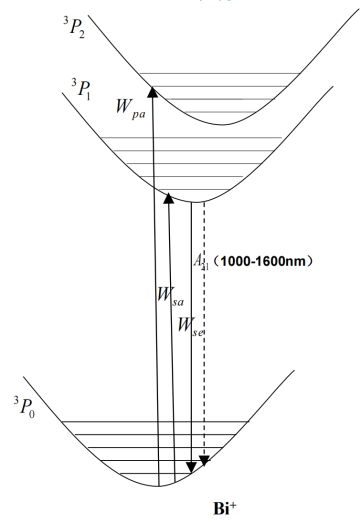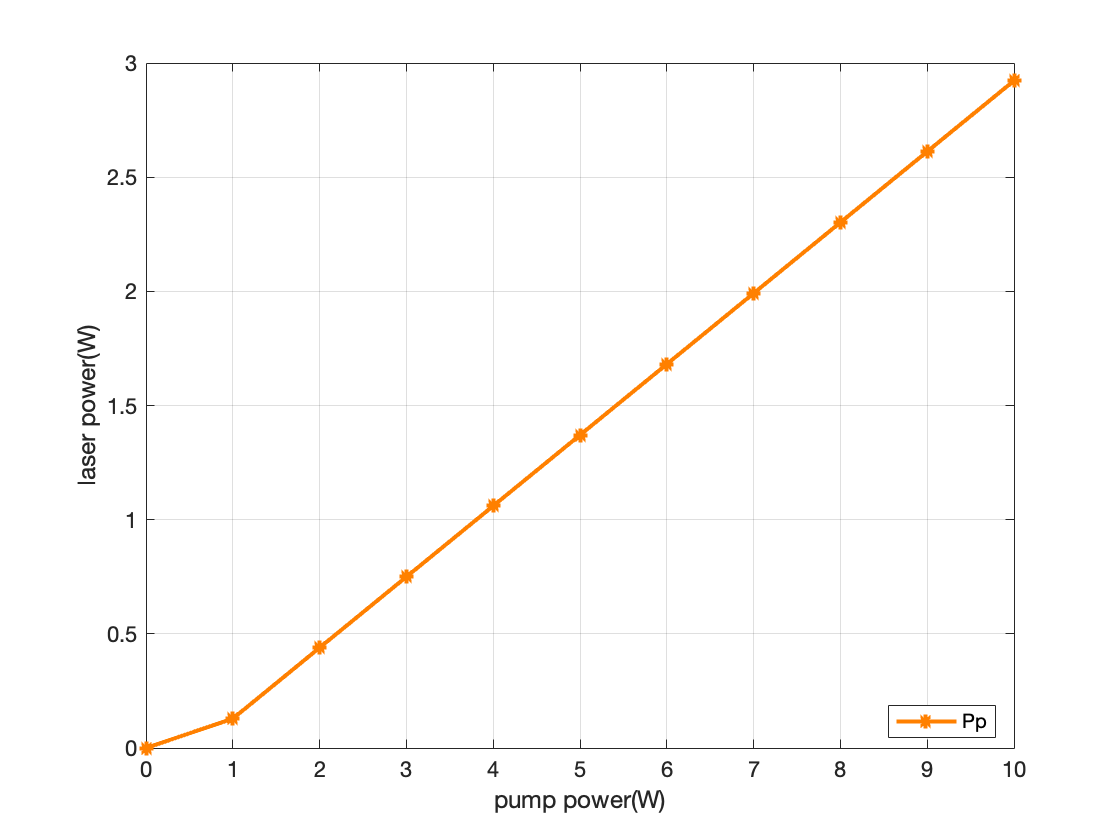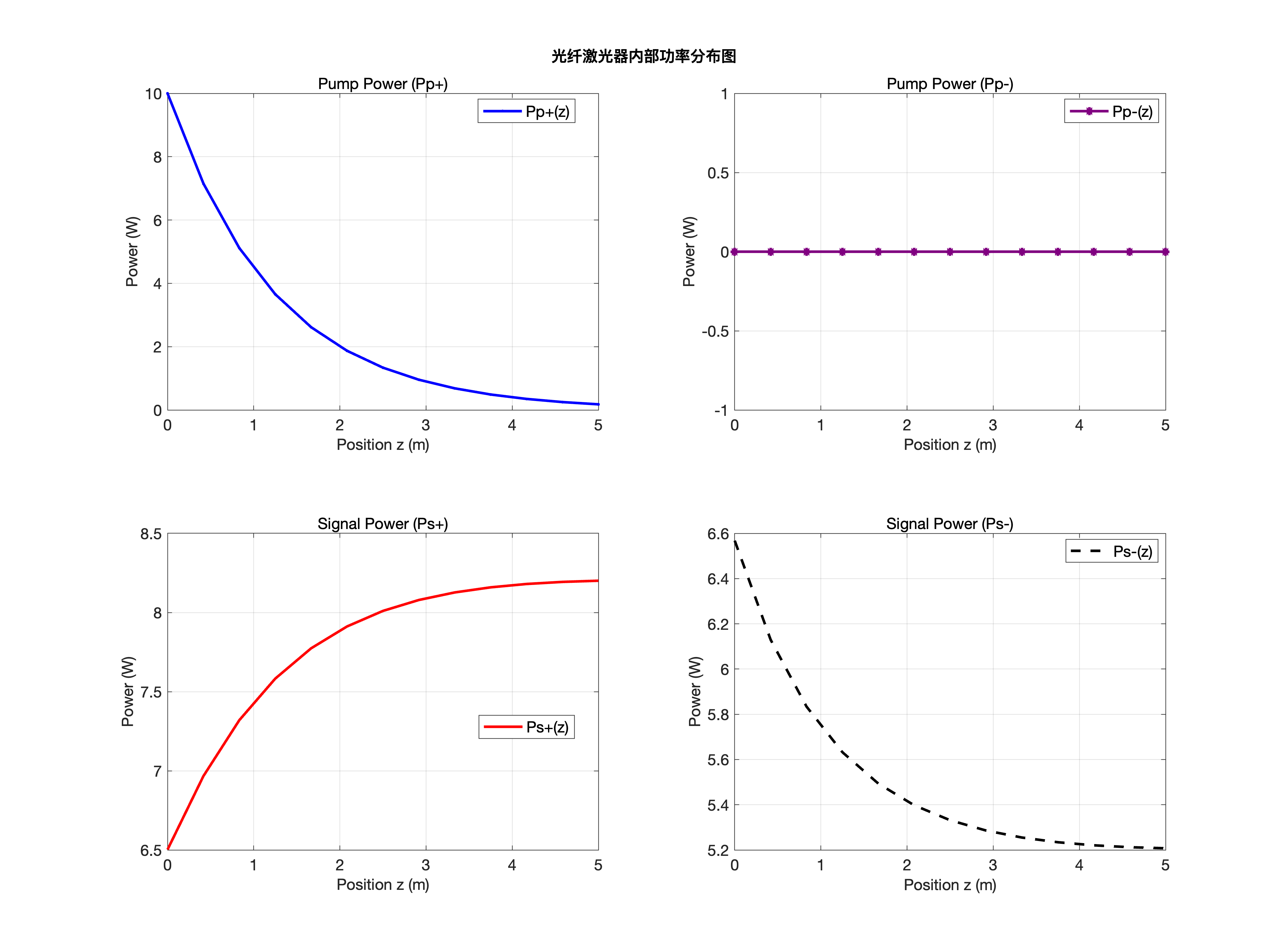1. Introduction
In recent years, laser systems functioning within the 1350-1400 nm spectral range exhibit notable promise for biomedical imaging and fiber-optic communication applications biomedical imaging, optical fiber communications, and industrial processing. Conventional rare-earth-ion-doped fiber lasers in this band face challenges such as low transition efficiency and narrow gain bandwidth. Bismuth (Bi)-doped fibers have emerged as an ideal candidate for achieving laser output in this range due to their unique near-infrared broadband luminescence (1100-1800 nm) and tunable active center structures. However, key scientific issues such as emission cross-section optimization, concentration quenching effects, and host matrix dependence remain unresolved. Bismuth-doped phosphosilicate fibers (BPSFs), with their emission range covering the second transmission window, have attracted widespread research attention [1]. In 2009, Dianov et al. first reported a bismuth-doped phosphogermanosilicate fiber that achieved a maximum gain of 24.5 dB and a noise figure of 5 dB at 1320 nm using a single-stage forward-pumping scheme, with a 3 dB gain bandwidth of 37 nm [2]. In 2016, the University of Southampton demonstrated a BPSF that delivered a flat gain of (25 ± 1) dB with a noise figure of 4–6 dB across the 1320–1360 nm wavelength under single-stage bidirectional pumping [3]. In 2021, the University of Southampton reported a BPSF capable of providing over 20 dB gain in the wavelength range of 1345–1460 nm. However, due to the absence of dehydration during fabrication, the gain was significantly affected by OH- absorption at 1380 nm [4]. In 2022, Tian J’s team successfully developed a low-loss bismuth/phosphorus co-doped fiber, achieving net gain across a 30 nm bandwidth in the E-band under bidirectional pumping, with a peak gain of nearly 20 dB at 1355 nm [5]. In March 2024, Liu Shaokun fabricated a high-germanium bismuth-doped optical fiber with a germanium dioxide (GeO₂) core mole fraction of approximately 42%, based on an improved chemical vapor deposition (CVD) technique. Absorption tests revealed a distinct Ge-related bismuth active center peak at 1650 nm. Through The fiber exhibited outstanding amplification characteristics in a single-stage configuration, achieving an unprecedented gain of 26.3 dB at 1670 nm and a corresponding efficiency of 0.165 dB/mW [6,7].
2. Models and methods
The energy level system of bismuth-doped fibers is generally considered to be a complex multi-level system, with the specific number of energy levels complex energy level system exhibiting composition-dependent characteristics based on bismuth species' chemical states and local glass environment interactions. Current research suggests that the luminescence characteristics of bismuth-doped fibers may involve several effective energy levels, though a rigorous theoretical model might require additional levels to accurately describe their non-radiative transitions and broadband emission behavior. For this study, a three-level system was adopted for investigation. The schematic diagram of the energy level system under study is shown in Figure 1. And the physical characteristics of the gain medium and the fiber laser's technical specifications are detailed in Table 1 .

|
Symbol |
Physical Parameter |
value |
unit |
|
Center wavelength of pump light |
793 |
nm |
|
|
Center wavelength of laser |
1400 |
nm |
|
|
τ |
Upper-level lifetime |
420 |
μs |
|
Pump absorption cross-section |
1.2×10^-20 |
cm^2 |
|
|
Pump emission cross-section |
0 |
cm^2 |
|
|
Laser absorption cross-section |
4.2×10^-21 |
cm^2 |
|
|
Laser emission cross-section |
6×10^-21 |
cm^2 |
|
|
Core cross-sectional area |
1.6×10^-11 |
m^2 |
|
|
N |
Dopant ion concentration |
5.535×10^19 |
cm^3 |
|
Pump loss coefficient |
2×10^−5 |
cm^-1 |
|
|
Signal loss coefficient |
4×10^−6 |
cm^-1 |
|
|
L |
fiber length |
1 |
m |
|
Pump power filling factor |
0.0024 |
||
|
Signal power filling factor |
0.82 |
||
|
Front mirror reflectivity |
0.99 |
||
|
Rear mirror reflectivity |
0.35 |
The following establishes the rate equations and power equations for the three-level system, these are the rate equations for bismuth ions in the three-level system and the evolution of pump power and lasing power along propagation length is governed by the power propagation equations [11].
3. Computational analysis
This study employs numerical simulation methods to establish the rate equations and power propagation equations for a 1400 nm bismuth-doped fiber laser, followed by their solution.
3.1. Laser output power
The power transfer characteristics between the optical pump and laser output were investigated in Figure 2. As shown in the figure 2, when the pump power is below 1 W, the growth rate of the output laser power is lower than when the pump power exceeds 1 W. Beyond the threshold, the output power increases linearly. This phenomenon may be attributed to either intrinsic fiber losses or incomplete population inversion of the active ions under low excitation conditions.

3.2. Internal power distribution in fiber laser
By establishing and solving the power propagation equations, we obtained the spatial evolution of forward pump power, backward pump power, forward signal power, and backward signal power within the fiber, as shown in Figure 3.

Analysis of the curves reveals the forward pump power decays exponentially, reaching its minimum value
3.3. Discussion
This study is based on computer numerical simulation, establishing a steady-state rate equation model for bismuth-doped fiber lasers, with a focus on analyzing the laser output characteristics and power distribution patterns in the 1350-1400 nm wavelength range. The main research findings are as follows: By solving boundary value problems, the threshold pump power of the laser was determined, and the linear growth relationship between output power and pump power was verified. The forward pump power exhibits exponential decay along the fiber, consistent with the physical principles of stimulated absorption and transmission loss. The laser signal shows an asymmetric distribution, with its peak position influenced by the coupling efficiency of the mirrors. Simulation results of backward pump power demonstrate that it approaches zero under single-end pumping conditions, conforming to the set boundary conditions.
Through numerical simulation, this study has validated the feasibility of bismuth-doped fiber lasers in the 1350-1400 nm wavelength range. However, further in-depth research is still required in areas such as dynamic characteristics and application optimization. On theoretical level, future work could introduce time variables to study relaxation oscillations and pulse dynamics and employ FEM or FDTD methods to simulate ultrashort pulse outputs like Q-switching or mode-locking, which are crucial for biological imaging and precision machining. In the biomedical field, this wavelength range falls within the tissue optical window, and optimizing laser linewidth and noise can enhance the performance of OCT and two-photon imaging. For fiber optic communications, bismuth-doped fibers can expand the communication capacity of the O-band, with a focus on addressing gain flattening and noise suppression. In industrial applications, lasers in this wavelength range are suitable for polymer processing and distributed sensing, necessitating the development of high-power amplification solutions. These studies will advance bismuth-doped fiber lasers from theory to practical applications, providing new light source solutions for biomedical, communication, and precision manufacturing fields. Future work should combine experimental validation, focusing on breakthroughs in dynamic performance control and key engineering application technologies to accelerate the industrialization process of bismuth-doped fiber lasers.
4. Conclusion
This study systematically analyzes the output characteristics of bismuth-doped fiber lasers in the 1350-1400 nm band through computer simulations, revealing the influence patterns of pump power, doping concentration, and mirror reflectivity on laser performance. The simulation results provide a theoretical basis for experimental design. Future research could further advance the practical application of bismuth-doped fiber lasers through dynamic modeling, thermal simulations, and experimental validation.
Through numerical simulations, this study verifies the feasibility of bismuth-doped fiber lasers in the 1350-1400 nm band, confirming their characteristics of broadband gain and efficient laser output. The results demonstrate that optimized bismuth-doped fibers can achieve stable laser performance in this wavelength range, laying a theoretical foundation for practical applications.
This research provides new light source options for biomedical imaging, optical fiber communications, and industrial processing. The development of bismuth-doped fiber lasers will drive technological advancements in related fields, holding significant scientific value and application potential. Future studies could further explore the dynamic characteristics of bismuth-doped fibers, such as pulse output and noise optimization, to meet the requirements of different application scenarios. Meanwhile, by combining experimental validation and engineering research, it is expected to accelerate the industrialization process of bismuth-doped fiber lasers, providing more efficient and stable laser solutions for multidisciplinary development.
References
[1]. Yin, X.K., He, L., Liu, S.K., et al. (2024) Phosphosilicate Bismuth-Doped Fiber Achieving O+E Band Amplification. Chinese Journal of Lasers, 51, 0206002.
[2]. Dianov, E.M., Mel'kumov, M.A., Shubin, A.V., et al. (2009) Bismuth-Doped Fibre Amplifier for the Range 1300-1340 nm. Quantum Electronics, 39, 1099.
[3]. Thipparapu, N.K., Umnikov, A.A., Barua, P., et al. (2016) Bi-Doped Fiber Amplifier with a Flat Gain of 25 dB Operating in the Wavelength Band 1320-1360 nm. Optics Letters, 41, 1518-1521.
[4]. Wang, Y., Thipparapu, N.K., Richardson, D.J., et al. (2021) Ultra-Broadband Bismuth-Doped Fiber Amplifier Covering a 115-nm Bandwidth in the O and E Bands. Journal of Lightwave Technology, 39, 795-800.
[5]. Tian, J., Guo, M., Wang, F., et al. (2022) High Gain E-Band Amplification Based on the Low Loss Bi/P Co-Doped Silica Fiber. Chinese Optics Letters, 20, 100602.
[6]. Liu, S.K., He, L., Yin, X.K., et al. (2024) High-Absorption Germanosilicate Bismuth-Doped Fiber and Its Gain Performance. Chinese Journal of Lasers, 51, 0206005.
[7]. Peng, M.Y., Wang, C., Qiu, J.R., et al. (2005) Novel Bismuth-Doped Luminescent Materials for Ultra-Broadband Fiber Amplifiers. Laser & Optoelectronics Progress, 42, 41-45.
[8]. Chen, W.F., Zhu, Y., Yang, L., et al. (2015) Spectral Characteristics of Bismuth-Doped Double-Clad Quartz Fiber. Optical Fiber & Electric Cable and Their Applications, 4, 37-39.
[9]. Zhou, S., Feng, G., Bao, J., et al. (2007) Broadband Near-Infrared Emission from Bi-Doped Aluminosilicate Glasses. Journal of Materials Research, 22, 1435-1438.
[10]. Li, C.S. (2017) Fluorescence Properties and Applications of Novel Bismuth-Doped Fibers. Beijing University of Posts and Telecommunications.
[11]. Guo, Z.H., Xu, C.Y. and Yao, J.L. (2023) Optimization of Bismuth-Doped Fiber Amplifier Gain Spectrum Based on Genetic Algorithm in 1200 nm-1600 nm. Journal of Physics: Conference Series.
Cite this article
Lin,Z. (2025). Numerical Simulation of Bismuth-Doped Fiber in 1350-1400 nm Laser Emission. Applied and Computational Engineering,182,35-41.
Data availability
The datasets used and/or analyzed during the current study will be available from the authors upon reasonable request.
Disclaimer/Publisher's Note
The statements, opinions and data contained in all publications are solely those of the individual author(s) and contributor(s) and not of EWA Publishing and/or the editor(s). EWA Publishing and/or the editor(s) disclaim responsibility for any injury to people or property resulting from any ideas, methods, instructions or products referred to in the content.
About volume
Volume title: Proceedings of CONF-FMCE 2025 Symposium: AI and Machine Learning Applications in Infrastructure Engineering
© 2024 by the author(s). Licensee EWA Publishing, Oxford, UK. This article is an open access article distributed under the terms and
conditions of the Creative Commons Attribution (CC BY) license. Authors who
publish this series agree to the following terms:
1. Authors retain copyright and grant the series right of first publication with the work simultaneously licensed under a Creative Commons
Attribution License that allows others to share the work with an acknowledgment of the work's authorship and initial publication in this
series.
2. Authors are able to enter into separate, additional contractual arrangements for the non-exclusive distribution of the series's published
version of the work (e.g., post it to an institutional repository or publish it in a book), with an acknowledgment of its initial
publication in this series.
3. Authors are permitted and encouraged to post their work online (e.g., in institutional repositories or on their website) prior to and
during the submission process, as it can lead to productive exchanges, as well as earlier and greater citation of published work (See
Open access policy for details).
References
[1]. Yin, X.K., He, L., Liu, S.K., et al. (2024) Phosphosilicate Bismuth-Doped Fiber Achieving O+E Band Amplification. Chinese Journal of Lasers, 51, 0206002.
[2]. Dianov, E.M., Mel'kumov, M.A., Shubin, A.V., et al. (2009) Bismuth-Doped Fibre Amplifier for the Range 1300-1340 nm. Quantum Electronics, 39, 1099.
[3]. Thipparapu, N.K., Umnikov, A.A., Barua, P., et al. (2016) Bi-Doped Fiber Amplifier with a Flat Gain of 25 dB Operating in the Wavelength Band 1320-1360 nm. Optics Letters, 41, 1518-1521.
[4]. Wang, Y., Thipparapu, N.K., Richardson, D.J., et al. (2021) Ultra-Broadband Bismuth-Doped Fiber Amplifier Covering a 115-nm Bandwidth in the O and E Bands. Journal of Lightwave Technology, 39, 795-800.
[5]. Tian, J., Guo, M., Wang, F., et al. (2022) High Gain E-Band Amplification Based on the Low Loss Bi/P Co-Doped Silica Fiber. Chinese Optics Letters, 20, 100602.
[6]. Liu, S.K., He, L., Yin, X.K., et al. (2024) High-Absorption Germanosilicate Bismuth-Doped Fiber and Its Gain Performance. Chinese Journal of Lasers, 51, 0206005.
[7]. Peng, M.Y., Wang, C., Qiu, J.R., et al. (2005) Novel Bismuth-Doped Luminescent Materials for Ultra-Broadband Fiber Amplifiers. Laser & Optoelectronics Progress, 42, 41-45.
[8]. Chen, W.F., Zhu, Y., Yang, L., et al. (2015) Spectral Characteristics of Bismuth-Doped Double-Clad Quartz Fiber. Optical Fiber & Electric Cable and Their Applications, 4, 37-39.
[9]. Zhou, S., Feng, G., Bao, J., et al. (2007) Broadband Near-Infrared Emission from Bi-Doped Aluminosilicate Glasses. Journal of Materials Research, 22, 1435-1438.
[10]. Li, C.S. (2017) Fluorescence Properties and Applications of Novel Bismuth-Doped Fibers. Beijing University of Posts and Telecommunications.
[11]. Guo, Z.H., Xu, C.Y. and Yao, J.L. (2023) Optimization of Bismuth-Doped Fiber Amplifier Gain Spectrum Based on Genetic Algorithm in 1200 nm-1600 nm. Journal of Physics: Conference Series.









